#raimund prince
Explore tagged Tumblr posts
Text

AU where my version of the Prince family lives, and Tobias isn't a jerk but is still hot-headed. After the prank families' meeting: Orion: Almost losing a half-blood isn't such big of a deal to- Tobias, pulling out a gun: Let's check if losing a pureblood's head is such a big deal.
closups:


#hp fanart#my art#princes family#severus snape#tobias snape#eileen snape#eileen prince#orion black#walburga black#sirius black#albus dumbledore#raimund prince#gustav prince#magda prince#it's my most crowded art so far#and i drew it for a joke basically lol#priorities#but it was fun to draw orion and walburga i've been thinking about drawing them for a while
550 notes
·
View notes
Text
Yurgenschmidt (6) Ahrensbach
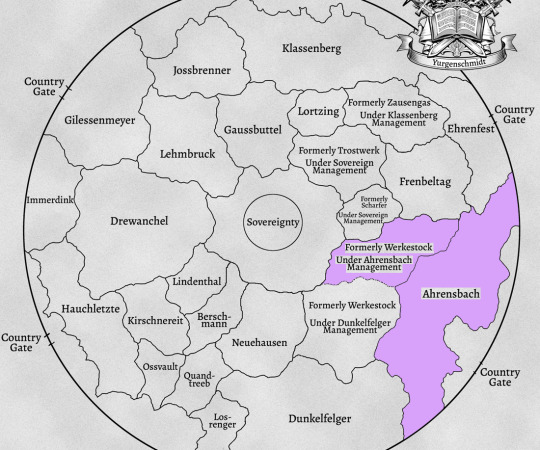
- - - (6th Rank) Ahrensbach (Light Purple Cloaks) - - -
Size ◈ Greater
Cape Color ◈ Light Purple
Key Crest Components ◈ Unicorn
Cultural Notes ◈ A duchy of trade. At the moment, it has the only open country gate in Yurgenschmidt.
- - - Archduke Family - - -
Aub Ahrensbach [ family tree ] - 1st wife Lady Georgine (frm 3rd wife) - Detlinde (daughter) - (adopted) Letizia (granddaughter)
Aub Ahrensbach younger brother - 3rd wife - Aurelia (daughter) - Martina (daughter)
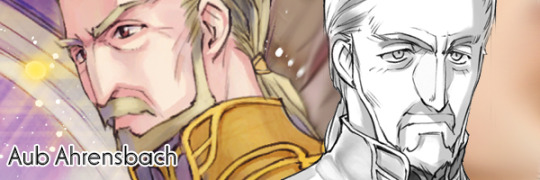
Aub Ahrensbach, Lord Gieselfried
dying of some mysterious illness
desperate to right his duchy with a new successor
determined to stabilize his duchy he petitions for Ferdinand to marry his daughter Detlinde to help her administer the duchy
also wants Ferdinand to educate his successor, his granddaughter Letizia
POV Chapters
LN16 - Part 4, Volume 4 - Epilogue
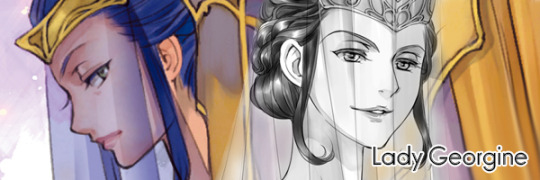
Lady Georgine
third wife to Aub Ahrensbach, made first wife after the pervious first wife died
older sister of Sylvester
was trained to be the Aub of Ehrenfest but was passed over in favor of Sylvester
is working to undermine Sylvester with the former Veronica faction nobles in Ehrenfest
has many loyal name-sworn nobles in Ehrenfest
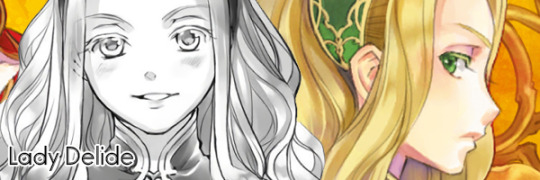
Lady Detlinde
Lady Georgine’s youngest daughter
golden blond hair, green eyes
(year 1) 4th year archduke candidate
antagonistic towards Rosemyne
(year 2) 5th year archduke candidate
is tasked with becoming the temporary Aub Ahrensbach until Letizia comes of age
is engaged to Ferdinand by orders of her father and the Zent
(year 3) 6th year archduke candidate
Part 5, Volume 2, Prologue
“Lady Detlinde is not nearly educated enough for us to work under her,” one said. “By the time she catches up, I expect Lady Letizia will have come of age.”
“We might have thought otherwise if she at least took the work seriously,” added another, “but, oh, how she hates studying. Though she may only be a temporary archduchess, I would expect a bit more... well...”
“She is underage. Plus, as the third child of a third wife, she has not had the opportunity to receive a political education before now. It would be cruel of us to demand too much from her.”
POV Chapters
LN20 - Part 4, Volume 8 - Epilogue
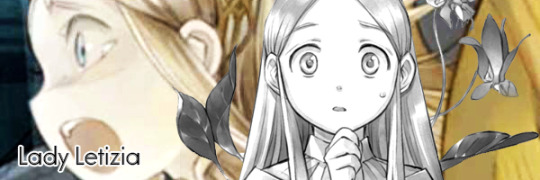
Lady Letizia
(year 2) 6 years old
adopted granddaughter, current successor to Aub Ahrensbach
(year 3) 7 years old, baptized
currently making noble connections in Ahrensbach
being tutored by Ferdinand
engaged to marry Prince Hildebrand when they come of age
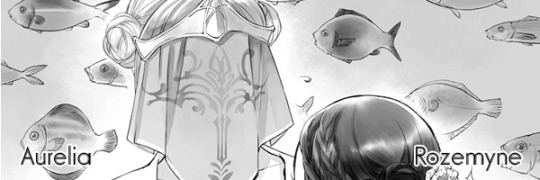
Lady Aurelia
recent graduate from the academy
older daughter of the last Aubs 2nd son’s, 3rd wife
recently married Myne’s brother Lamprecht
looks a lot like Lady Veronica / Gabrielle so always wears a veil because she is afraid of causing offense to the people in Ehrenfest
POV Chapters
LN17 - Part 4, Volume 5 - Extra - Reaching a Crossroads
Lady Martina
younger daughter of the 2nd son’s, 3rd wife
attendant to Detlinde
resembles Tuuli
- - - Notable People - - -
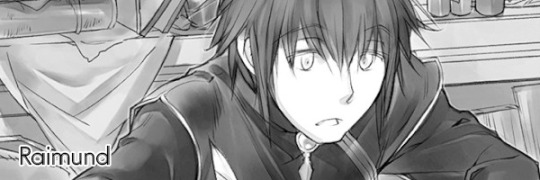
Lord Raimund
mednoble scholar, low mana
disciple of Hirschur and Ferdinand
good at modifying magical tools to use less mana
admires Ferdinand and wants to become his retainer one day
Part 5, Volume 2, Prologue (Ferdinand)
Initially, Ferdinand had spoken to Raimund simply because Rozemyne had taken a liking to the young student. He had then accepted him as a disciple as a means of observing him while simultaneously gathering information on Ahrensbach. By this point, however, Ferdinand found reading his unique perspectives and answering his questions by letter a source of great comfort.
Sergius
Ahrensbach attendant assigned to Ferdinand
yellow-eyes

Count Bindewald
working with dissidents (Veronica/Georgine faction) in Ehrenfest
friend of the former High Bishop Bezewanst
tried to force Myne to sign a submission (slave) contract
was captured by Ferdinand and Sylvester and held for questioning
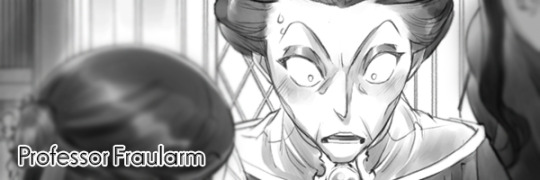
Professor Fraularm
Academy Dormitory Advisor, Scholar course
hates Rozemyne and Ehrenfest
her little sister was married to Count Bindewald, blames Rozemyne for that incident [LN23]
working with Lady Georgine
- - - Duchy Notes - - -
Part 5, Volume 2, Prologue (Ferdinand)
The purge had seen the second wife’s two sons reduced to archnobles, Detlinde’s older brother had perished in an unfortunate accident, and Aub Ahrensbach had died before Letizia (his oldest daughter’s daughter) came of age. Detlinde was thus having to serve as a temporary archduchess.
As there was no Lord of Winter to hunt in Ahrensbach, the duchy’s knights did not put special effort into their training.
Those in Ahrensbach had no need to socialize intensely and gather information before the snow grew unreasonably heavy. Adults in particular were afforded a lot more flexibility; nobles rarely spent all day in the castle, and children accompanied their guardians while socializing instead of spending that time in the winter playroom. Even the archduke candidate Letizia, whom Ferdinand was working to educate, had prioritized strengthening bonds with the others in her faction.
Ahrensbach nobles came together in the afternoon, when it was warmer. During the winter, they tended to stay inside until fourth bell and start their day after lunch—unless they were invited to lunch, that is. In contrast, during the summer when the sun beat down mercilessly, nobles barely went outside between third and fifth bell.
- - - Updated January 16, 2023 - - -
These are just my quick notes to remember important info and/or passages as I read the series. I updated it as I read each volume and find new info I want add. I try and remember to mark each piece of info with at least the LN# for reference. If you find a mistake, or think I need to add something else, please leave a comment and I’ll add it.
#ascendance of a bookworm#honzuki no gekokujou#bookworm light novel#Work In Progress#bookworm notes#duchy ahrensbach
6 notes
·
View notes
Note
Can you tell us everything you know about Mozart?
Wow okay so I can try??? My memory is insanely bad but ofc!!
So. I guess I'll just do a biography with like.... everything i know
Wolfgang Amadeus Mozart was born in 1756, Salzburg, Austria. He was baptized with the name Johannes Chrysostomus Wolfgangus Theophilus Mozart, but he really didn't like it- in fact, most of his life he went by different names. (Gottlieb, Wolfgango Amadeo, Wolfgang Amade)
He grew up with his father (Leopold Mozart), his mother (Anna Maria Mozart), and his sister (Nannerl Mozart). He learned violin and piano at the age of 4, which his father saw potential in. Leopold being a musician, he had the ability to help him compose, writing down the notes while young Wolfgang played the pieces. At the age of 6, Mozart wrote a minuet and a trio for keyboard, the future number 1 of the Köchel catalogue. But with his father, Leopold practically controlled Mozart's life up until his twenties. He controlled where he went, what he studied, where he stayed, and much more; but Wolfgang didn't mind, he really enjoyed the performing. He performed for the French king Louis XV and Madame Pompadour, then for the English family, where he was taught by Bachs son, Johann Christian Bach. In England, he wrote his first symphony and 40 other works. Around the time of 1777, Wolfgang Amadeus Mozart was 21, and was out of his fathers grasp, since he was busy with the Prince-Archbishop Colloredo. He was meant to go back to Paris with his mother, until he met Aloysia Weber, who he fell in love with; and just so happened to be the sister of his future wife, Constanze Weber. Instead, he went on a concert trip with the Webers to the Hague, which enraged his father. It didn't bring any money into the family. In Paris 1778, Wolfgang watched his mother pass away on her deathbed. Doctors were called, but none arrived. She had grown sick as Wolfgang was unable to find work, barely any food came in, and the room they stayed in was constantly dark and cold. In 1779, Aloysia had became famous and had rebuffed Mozart. Mozart and his music had matured around this point. He went to Vienna, where his career soon picked up once again. In 1781, he fell in love with Constanze, but in fear of his father controlling the relationship he didnt dare tell him that he planned on marrying her. In 1782, they got married. Mozart constantly composed. When it came to money, he was now very well off. At the time where Mozarts first son, Raimund Leopold was born, he met Joseph Haydn, who taught him how to write and compose quartets.
In 1787, Wolfgangs father died. Mozart was extremely upset. Filled with grief, and desperate for money, he set to work on his famous opera "Don Giovanni". It was an outlet for his despair to work on it; the seducer of women going to hell. Later on in Mozarts life, the enjoyment of his music was stricken down. He never played for the fun of it, he only played for the money. When the money came in, he spent it carelessly. In 1790, Mozart went into debt once more. Nobody wanted to hear from the small unattractive man when names like "Salieri" were in high demand. Near the end of his life when he was writing his by far most famous opera "The Magic Flute", he was most sad and lonely. His wife wasn't at his side and had been staying at a health spa. To write the opera without his source of happiness and support drove him even further into the ground. In 1791, Mozart accepted commissions from anyone as long as they were putting down money. While in the middle of composing The Magic Flute, he had received an anonymous commission to write a Requiem. Alongside that, he had received a commission to finish an opera within 4 weeks. He was growing to be weak, more depressed every single day. His friends often wrote that he always had a glass of wine in his hand, not ever going one day without drinking. He was under so much stress, his time management had never been worse: but he needed the money. His Requiem is often connected to Antonio Salieri, due to the famous movie "Amadeus" only making the previous rumors grow. It was believed that Salieri was the cause of his death, but in reality the two had a very professional and friendly relationship and had nothing but respect for each other. Salieri had nothing to do with the requiem, in fact, it was Count Franz Walsegg-Stuppach, a very small composer who wanted to perform it after the death of his wife and claim authorship for it. Fortunately though, Mozart lived to see the premier of The Magic Flute, which was overwhelmingly successful. He died happy, but pretty poor. Pretty sure he was burried in a mass grave too
#here <3#this took me forever to write goodbye#i know much more small facts but this is just the most important biography shit#mozart
46 notes
·
View notes
Text
Christmas Fairytale Vote 2019 | Round 1 - Part 1

The Vote is over. Princess Maleen and About the Youth Who Went Forth to Learn What Fear Was move on to Round 2.
How it works As mentioned on my youtube channel, I want to translate a fairytale adaptations for Christmas but I cannot decide on which one because there are so many. Usually I would do one poll but youtube only allows for five options, so this will be done in rounds. In the first round, the two movies with the most votes per part will move to the next round where they will be set against the other parts winners. In round 2, a winner and a second place of different parts of round 1 compete against one another. The winner of each poll moves on to the final round where the Christmas Fairytale Movie I will translate 2019 will be decided on. Overall you will be able to choose your winner out of 15 movies.
The Contestants
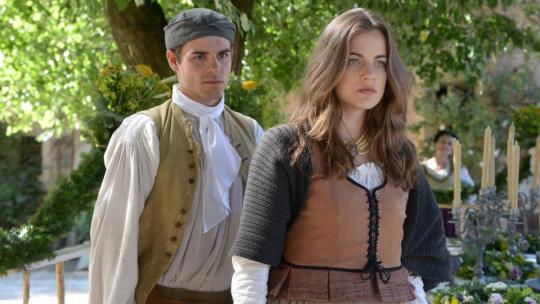
Prinzessin Maleen [Princess Maleen]
According to her father's will, Princess Maleen is supposed to marry Baron Raimund. For seven years, she is imprisoned in a tower but she cannot forget her true love, Landgrave Konrad. Finally freed, Maleen finds a devasted land, and her father is dead. During her travels, Maleen also come to Konrad's estate. There the wedding to the extraordinary ugly Walpurga is being prepared.
With Cleo von Adelsheim, Peter Foyse, Paula Paul, Lucas Reiber, Mariella Ahrens, Konrad Hochgruber and more

Jorinde und Joringel [Jorinde and Joringel]
Jorinde and Joringel dream of a future together. But since Joringel only works as servant on Jorinde's father's court, he thinks him to be a wastrel and varmint. He wants something better for his daughter. When he forbids them to marry, the lovers flee. The only safe way for the searching parents leads through the enchanted forest. It has been avoided by the people for many years.
With Llewellyn Reichmann, Jonas Nay, Mika Seidel, Katja Flint, Uwe Kockisch, Naomi Krauss, Veit Stübner and more.

Das singende, klingende Bäumchen [The Singing Ringing Tree]
The beautiful princess must grow up without her mother. Her father loves her but his loves consists of keeping her away from the real life and all challenges. Often alone with her self, the princess grows up to be an arrogant and cold-hearted young woman. When her father wants to marry her off, she declines. She wants to own the singing ringing tree. But she does not know that it only rings with true love.
With Jytte-Merle Böhrnsen, Lucas Prisor, Christel Bodenstein, Steffi Kühnert, Heinz Hoenig, Oli Bigalke, Gro Swantje Kohlhof and more.

Vom Fischer und seiner Frau [The Fisherman and His Wife]
A fisherman lives with his wife Ilsebill in an old tub by the sea. One day, the fisherman catches a halibut who is an enchanted prince and lets him free again. Ilsebill asks her husband if he did not wish for anything in exchange for the fish's freedom. Again and again she demands of her husband to aks the halibut for bigger and bigger things.
With Katharina Schüttler, Fabian Busch, Jan Fedder, Peter Heinrich Brix, Leander Lichti, Rudolf Kowalski, Patrick Heyn, Catrin Striebeck und Alexander Simon.

Von einem, der auszog das Fürchten zu lernen [About the Youth Who Went Forth to Learn What Fear Was]
Potter's son Michel just cannot fear, not even a little bit. He sets out into the world, to learn to fear. Princess Elisabeth lives with her father, The King, in a makeshift tent city. The King's castle is occupies by ghosts. That is why The King promised his daughter to the person who can end the haunting of the castle. But so far all contestants failed.
With Tim Oliver Schultz, Isolda Dychauk, Milan Peschel, Heiner Lauterbach, Michael Kessler, Rick Kavanian, Anna Thalbach and more.
9 notes
·
View notes
Text
Visitors
Forgot to mention last time, the story is also on AO3 (along with Soulmates), where you can find the first part if you missed it. Part 2.
“Ryland,” Mimi said, not looking up from the parchment scrap in her hand as she walked into the kitchen. “I need three guest rooms prepared as soon as possible. Solaire,” she turned to the fairy, “we will need to review the menu for the next week and ensure we have enough vegetarian dishes.”
“Who are we expecting, milady?” she asked, setting aside the bread she was kneading and wiping her flour-covered hands on her apron.
“Queen Ishara and two of her children,” she replied, handing the message over to her.
Mimi wasn’t entirely sure what her first memory of the Idreis family was, they were such an integral part of her life.
Still, she wasn’t sure what to do when she received a note from her father (which comprised a majority of their interactions at the moment) that Queen Ishara, Dragon Master Imohn, and Prince Iseul were en route to their castle. Queen Ishara was like a second mother to Mimi and this was her first time hosting anyone without any support from her mother. When it was just her.
A dull ache throbbed in her chest at the thought, but she did her best to ignore it. Just breathe, she thought.
It had been less than a week since the funeral and the only time she truly felt any peace was when she was pouring over her healing books or keeping the castle running. She slept little, plagued by a sense of dread whenever she shut her eyes.
She always needed to be doing something.
“Now, we’ll take out the roast beef and have vegetable stew instead,” she told Solaire, crossing out the line on the weekly menu that she had brought out and put ‘vegetable stew’ above it. “Queen Ishara is quite fond of it, from what I remember.”
“Yes, milady,” the fairy said, nodding.
As they continued to modify the menu, Mimi’s thoughts wandered to what else she had to do today, beyond prepare for their unexpected arrivals. There was a letter from Cerdic that needed a response, not to mention she needed to review the budget for the year so that she could advise her father on the domestic parts, as well as approve various forms and requests from the servants for supplies and time off and...
Gods, she had a headache even thinking about it.
Her headache had only intensified and when the elven delegation finally arrived late at night, her spells doing her no good. Still, it didn’t matter how she felt and she put on the best smile she could as the Idreis family came through the gates.
“Ishara,” Alaric said, his smile almost rusty from disuse. “It is good to see you.”
“I wish I was visiting in happier times,” she said, gracefully dismounting. Imohn did with the same grace; Iseul’s was much more flamboyant.
“It is good all the same,” he said, exchanging a bow with her. Mimi matched him, sinking into a deep curtsy.
“Queen Ishara, welcome,” she said, her voice sticking in her throat. She breathed deeply, trying to release the pent-up nerves she held in her chest. “Dragon Master Imohn, Prince Iseul.” She gave them each a nod of their own, which they responded to in kind. “I am sure you are all tired from your journey. I will show you to your rooms.”
“Actually,” Queen Ishara said, “I was hoping that I could speak to your father first, privately.”
“Of course,” she said. “I will have the servants take your things to your room.”
“Thank you, my dear,” she said, smiling warmly at the young woman. “And I am sure your father can show me the way,” he harrumphed in surprise, “when we are finished talking. You need not stay up on my account.”
“As you wish,” she said, knowing Queen Ishara always got her way in the end and that resisting was an exercise in futility. “Your Highnesses, if you would follow me.”
To be truthful, Mimi was also grateful for the Queen’s insistence, because she was about to drop dead from exhaustion. She had been up since before dawn and it was the middle of the night. Aldric had been asleep for hours at this point.
Why is it that the heir has an easier time of it than the spare?
“You know, Mimi,” Iseul said. “It is odd to hear you refer to us by our titles.”
“You know my father would have a fit if he heard me be so informal in public,” she said, her voice slightly slurred from exhaustion.
“I must agree with my brother for once,” Imohn said. “It would be like hearing Iraia do it.”
“Take it up with my father. Until then, you must bear with it,” she said, stopping at a door. “Here’s your room, Imohn. Iseul, yours is that one.” She pointed to the door to their left.
“You will not take me there yourself?” he asked, giving her one of his infamous smirks.
“You are a grown elf,” she said, patting his head in a way she knew he hated. “I have faith in your abilities to walk a few feet on your own.”
“Ah, but the loneliness may kill me!” he said, putting one hand on his forehead.
“Well, I suppose that is a risk we must take,” she said dryly. “Good night.”
“Good night, Raimunde,” Imohn said, giving her a bow that she returned.
When she collapsed into her own bed, too exhausted to even get out of her clothes, she fell asleep instantly. For once, she didn’t remember her dreams at all.
14 notes
·
View notes
Text
Holidays 9.14
Holidays
Board Game Day
Burning of King Olaf (Elder Scrolls)
Cochabamba Day (Bolivia)
Eleven Days of Global Unity, Day 4: Economic Justice
Engineer’s Day (Romania)
Formation of the Earth Day
Hole-in-One Day
Hug A Crabby Stranger Day
International Cross-Culture Day
Kenny Rogers Day (Los Angeles, California)
Lighthouse Day
Lone Ranger Day
Max Planck Day
Mobilized Servicemen Day (Ukraine)
National Anthem Day
National Coloring Day
National Live Creatively Day
National Parents Day Off
National Quiet Day (UK)
National Sober Day
National Virginia Day
Nutting Day (UK)
Pilgrimage to the Black Madonna of Einsiedeln (Switzerland)
San Jacinto Day (Nicaragua)
Star Spangled Banner Day
Support Latino Business Day
Tithi of Sri Sri Madhabdeva (Assam, India)
U.S. Marshall Service Day
Wo-Zha-Wa Festival
Food & Drink Celebrations
Cream-Filled Doughnut Day
Eat a Hoagie Day
Gobstopper Day
National Food is Medicine Day
Pig's Face Feast
Feast Days
Aelia Flaccilla (Eastern Orthodox Church)
Catherine of Genoa (Christian; Saint)
Cormac mac Cuilennáin (or of Cashel; Christian; Saint)
Crescentius of Rome (Christian; Saint)
Despair for the Human Race (Pastafarian)
Elevation of the Holy Cross (Eastern Orthodox)
Exaltation of the Holy Cross
Feast of Notburga of Eben (patron of waiters & farmers)
Feast of the Cross (Christianity)
Feast of Uru-Wadu (the Primal Couple; Kisar Island, Indonesia)
Fido (Muppetism)
Hindi Day (Parts of India; Hinduism)
Holy Cross Day (aka Holy Rood Day)
Lessing (Positivist; Saint)
Lord of Miracles of Buga (Christian; Saint)
Louis Gabriel Taurin Dufresse (Christian; One of Martyr Saints of China)
Maternus of Cologne (Christian; Saint)
Notburga (Christian; Saint)
Vaughan Bode Day (Church of the SubGenius; Saint)
Lucky & Unlucky Days
Prime Number Day: 257 [55 of 72]
Tomobiki (友引 Japan) [Good luck all day, except at noon.]
Umu Limnu (Evil Day; Babylonian Calendar; 42 of 60)
Premieres
Across the Universe (Film; 2007)
The Archies (Animated TV Series; 1968)
The Care Bears (Animated TV Series; 1985)
Crisis? What Crisis?, by Supertramp (Album; 1975)
A Discovery of Witches (TV Series; 2018)
The Dragon Prince (Animated Film; 2018)
Funeral, by Arcade Fire (Album; 2004)
Get Born, by Jet (Album; 2003)
The Golden Girls (TV Series; 1985)
The Hunger Games, by Suzanne Collins (Novel; 2008) [#1]
The Invention of Lying (Film; 2009)
The Magnificent Seven (Film; 2016)
Making Plans For Nigel, by XTC (Song; 1979)
The Messiah, by George Frederic Handel finished (Oratorio; 1741)
Mork and Mindy (TV Series; 1978)
Quadrophenia (Film; 1979)
Some Fantastic Place, by Squeeze (Album; 1993)
Tiny Toon Adventures (Animated TV Series; 1990)
Tutti Frutti recorded, by Little Richard (Song; 1955)
The Waltons (TV Series; 1971)
Today’s Name Days
Kreuz-Erhöhung (Austria)
Krustan, Krustina, Krustyo, Stavri (Bulgaria)
Slavko, Višeslav (Croatia)
Radka (Czech Republic)
Raimo, Raimond, Raimu, Raimund, Reimo, Reimu (Estonia)
Iida, Iita, Isla (Finland)
Albert, Irmgard, Jens, Kreuzerhöhung (Germany)
Stavros, Stavroula, Theoklis (Greece)
Roxána, Szeréna (Hungary)
Crocifisso, Elena (Italy)
Koknesis, Norberts, Sanda, Sanita, Santa (Latvia)
Eisvina, Eisvinas, Krescencijus (Lithuania)
Ingebjørg, Ingeborg (Norway)
Bernard, Cyprian, Roksana, Siemomysł, Szymon (Poland)
Ľudomil (Slovakia)
Cruz, Exaltación (Spain)
Ida (Sweden)
Keisha, Lakeisha, Latasha, LaTease, Latisha, Leticia, Letitia, Letty, Tish, Tisha (USA)
Today is Also…
Day of Year: Day 257 of 2022; 108 days remaining in the year
ISO: Day 3 of week 37 of 2022
Celtic Tree Calendar: Muin (Vine) [Day 12 of 28]
Chinese: Month 8 (Guìyuè), Day 19 (Geng-Wu)
Chinese Year of the: Tiger (until January 22, 2023)
Hebrew: 18 ʼĔlūl 5782
Islamic: 17 Ṣafar 1444
J Cal: 17 Aki; Twosday [17 of 30]
Julian: 1 September 2022
Moon: 80%: Waning Gibbous
Positivist: 5 Shakespeare (10th Month) [Lessing]
Runic Half Month: Ken (Illumination) [Day 5 of 15]
Season: Summer (Day 85 of 90)
Zodiac: Virgo (Day 22 of 31)
Calendar Changes
September (Julian Calendar) [Month 9 of 12]
1 note
·
View note
Text
Holidays 9.14
Holidays
Board Game Day
Burning of King Olaf (Elder Scrolls)
Cochabamba Day (Bolivia)
Eleven Days of Global Unity, Day 4: Economic Justice
Engineer’s Day (Romania)
Formation of the Earth Day
Hole-in-One Day
Hug A Crabby Stranger Day
International Cross-Culture Day
Kenny Rogers Day (Los Angeles, California)
Lighthouse Day
Lone Ranger Day
Max Planck Day
Mobilized Servicemen Day (Ukraine)
National Anthem Day
National Coloring Day
National Live Creatively Day
National Parents Day Off
National Quiet Day (UK)
National Sober Day
National Virginia Day
Nutting Day (UK)
Pilgrimage to the Black Madonna of Einsiedeln (Switzerland)
San Jacinto Day (Nicaragua)
Star Spangled Banner Day
Support Latino Business Day
Tithi of Sri Sri Madhabdeva (Assam, India)
U.S. Marshall Service Day
Wo-Zha-Wa Festival
Food & Drink Celebrations
Cream-Filled Doughnut Day
Eat a Hoagie Day
Gobstopper Day
National Food is Medicine Day
Pig's Face Feast
Feast Days
Aelia Flaccilla (Eastern Orthodox Church)
Catherine of Genoa (Christian; Saint)
Cormac mac Cuilennáin (or of Cashel; Christian; Saint)
Crescentius of Rome (Christian; Saint)
Despair for the Human Race (Pastafarian)
Elevation of the Holy Cross (Eastern Orthodox)
Exaltation of the Holy Cross
Feast of Notburga of Eben (patron of waiters & farmers)
Feast of the Cross (Christianity)
Feast of Uru-Wadu (the Primal Couple; Kisar Island, Indonesia)
Fido (Muppetism)
Hindi Day (Parts of India; Hinduism)
Holy Cross Day (aka Holy Rood Day)
Lessing (Positivist; Saint)
Lord of Miracles of Buga (Christian; Saint)
Louis Gabriel Taurin Dufresse (Christian; One of Martyr Saints of China)
Maternus of Cologne (Christian; Saint)
Notburga (Christian; Saint)
Vaughan Bode Day (Church of the SubGenius; Saint)
Lucky & Unlucky Days
Prime Number Day: 257 [55 of 72]
Tomobiki (友引 Japan) [Good luck all day, except at noon.]
Umu Limnu (Evil Day; Babylonian Calendar; 42 of 60)
Premieres
Across the Universe (Film; 2007)
The Archies (Animated TV Series; 1968)
The Care Bears (Animated TV Series; 1985)
Crisis? What Crisis?, by Supertramp (Album; 1975)
A Discovery of Witches (TV Series; 2018)
The Dragon Prince (Animated Film; 2018)
Funeral, by Arcade Fire (Album; 2004)
Get Born, by Jet (Album; 2003)
The Golden Girls (TV Series; 1985)
The Hunger Games, by Suzanne Collins (Novel; 2008) [#1]
The Invention of Lying (Film; 2009)
The Magnificent Seven (Film; 2016)
Making Plans For Nigel, by XTC (Song; 1979)
The Messiah, by George Frederic Handel finished (Oratorio; 1741)
Mork and Mindy (TV Series; 1978)
Quadrophenia (Film; 1979)
Some Fantastic Place, by Squeeze (Album; 1993)
Tiny Toon Adventures (Animated TV Series; 1990)
Tutti Frutti recorded, by Little Richard (Song; 1955)
The Waltons (TV Series; 1971)
Today’s Name Days
Kreuz-Erhöhung (Austria)
Krustan, Krustina, Krustyo, Stavri (Bulgaria)
Slavko, Višeslav (Croatia)
Radka (Czech Republic)
Raimo, Raimond, Raimu, Raimund, Reimo, Reimu (Estonia)
Iida, Iita, Isla (Finland)
Albert, Irmgard, Jens, Kreuzerhöhung (Germany)
Stavros, Stavroula, Theoklis (Greece)
Roxána, Szeréna (Hungary)
Crocifisso, Elena (Italy)
Koknesis, Norberts, Sanda, Sanita, Santa (Latvia)
Eisvina, Eisvinas, Krescencijus (Lithuania)
Ingebjørg, Ingeborg (Norway)
Bernard, Cyprian, Roksana, Siemomysł, Szymon (Poland)
Ľudomil (Slovakia)
Cruz, Exaltación (Spain)
Ida (Sweden)
Keisha, Lakeisha, Latasha, LaTease, Latisha, Leticia, Letitia, Letty, Tish, Tisha (USA)
Today is Also…
Day of Year: Day 257 of 2022; 108 days remaining in the year
ISO: Day 3 of week 37 of 2022
Celtic Tree Calendar: Muin (Vine) [Day 12 of 28]
Chinese: Month 8 (Guìyuè), Day 19 (Geng-Wu)
Chinese Year of the: Tiger (until January 22, 2023)
Hebrew: 18 ʼĔlūl 5782
Islamic: 17 Ṣafar 1444
J Cal: 17 Aki; Twosday [17 of 30]
Julian: 1 September 2022
Moon: 80%: Waning Gibbous
Positivist: 5 Shakespeare (10th Month) [Lessing]
Runic Half Month: Ken (Illumination) [Day 5 of 15]
Season: Summer (Day 85 of 90)
Zodiac: Virgo (Day 22 of 31)
Calendar Changes
September (Julian Calendar) [Month 9 of 12]
0 notes
Text
Semi-Useful Notes for Writing for THE ROYAL TUTOR
(Author’s Note: This includes all twelve episodes of the anime (plus the movie), as well as up through Chapter 84 of the manga (18 Oct 2019) and what info I can glean from the Character Book (unfortunately it’s all in Japanese). I will continually update this post as the series progresses and new spiffy stuff shows up, so visit my Master List of my ROYAL TUTOR Stuff to see the latest version.)
While writing A Noble Soul (which is done, by the way!), I had the idea that I personally love the little touches of authenticity that make a story more 'real,' and hey, if nothing else, I learn a few things along the way. (I *am* a researcher, after all!) So I did a lot of searching to find the real-world analogues of the buildings, references, history, and so forth from the series. As you’ll see in the descriptions, I explain how I determined which ones were which.
You’re welcome to post questions, comments, share this, etc. Hope it helps anyone else who wants to write for the ROYAL TUTOR fandom! (Quick question - would everyone prefer me to include chapter references for stuff? It’d make this post much longer, but if the fandom thinks it’d be useful, I can give it a shot.)
So, here we go!
GRANZREICH FAMILY INFO
Viktor von Granzreich, current ruler of the kingdom of Granzreich, assumed the throne at 18 (considering his father’s much later death, this may have been for reasons of health on his father’s part, possible abdication on his father’s part, or other political reasons)
Maria von Granzreich, Viktor’s mother, still living
NOTE: Her sibling (name and gender as yet unmentioned) is the Queen’s parent
Father’s name as yet unmentioned, died of natural causes at ‘a ripe old age’
NOTE: The princes mention in earlier chapters that they do remember their grandfather from when they were small, so his death is relatively recent)
Viktor’s wife (appears only once in flashback, name as yet unmentioned)
NOTE: One of her siblings (not sure if brother or sister) is the parent of Beatrix von Lothringen
(Beatrix also has three younger brothers and one younger sister)
Viktor’s children:
Eins von Granzreich, Viktor’s eldest child and firstborn son
Kai von Granzreich, Viktor’s second son
Currently engaged to Beatrix von Lothringen, first cousin to the princes
Bruno von Granzreich, Viktor’s third son
Leonhard von Granzreich, Viktor’s fourth son
Licht von Granzreich, Viktor’s fifth son
Adele von Granzreich, Viktor’s sixth child and only daughter
LOCATIONS:
GRANZREICH (real world analogue: Austria)
Granzreich population: ~6 million
Side note: Both Viktor and Leonhard are shown riding white horses - these are the famed Lipizzaner stallions, from the Spanish Riding School of Vienna, Austria
Other side note: Viktor’s typical outfit is clearly inspired by the military field uniform of Franz Josef I, Emperor of Austria (the white variant that the princes wear on some of the covers/inside art is the gala/formal version); the three medals shown on Viktor’s uniform are the Order of the Golden Fleece around his neck, what appears to be a simplified version of the Long Service Cross over his heart, and what appears to be a simplified version of a Knight Grand Cross of the Order of Maria Theresa just below that (a round circle with a cross).
90% of Granzreich’s population is Gherman (see below)
3% of Granzreich’s population is Kvel (see below)
Wienner (capital) (real world analogue: Vienna, Austria)
Wienner's population: ~1.3 million
Weissburg/Weisburg Palace (both spellings are used) (real world analogue: Hofburg Palace, Vienna, Austria) - specifically, the part often shown as denoting the palace is the Neue Berg wing
Karl Theater (real world analogue: Carltheater) - operettas
Remnant Theater (possible real world analogue: Raimund Theatre) - operettas
National Opera House (real world analogue: Staatsoper (originally Vienna Court Opera)) - opera house
National Art Museum (real world analogue: Kunsthistorisches Museum - directly opposite the palace, it is the largest art museum in the country; the image of the museum behind Heine when he announces the prize matches the façade of the building)
Granzreich University (real world analogue: there is no University of Austria, per se, but there is the University of Graz (the second largest city in Austria), which is the second largest and second oldest university in Austria)
Wienner University (real world analogue: University of Vienna, the building shown in both the anime and the manga is the main building - this is where Doctor Dmitri (and later Bruno) comes to lecture – it is also recognized as a leading institution for studies in Humanities – Bruno would do well here studying Philosophy!)
Prunksaal (real world analogue: Prunksaal) – the national library (also housed within the palace in another building)
Within the Prunksaal is the Royal Archive, where historical documents, judicial records, going back hundreds of years, and other documents the royal family keeps from one generation to another are preserved; only royals and a fraction of statesmen are permitted to use it (this is the place referenced in the anime that Prince Licht says even princes can’t visit without the king’s express permission)
The plaza/fountain where the KaseKrainer stand is (real world analogue: Donnerbrunnen Fountain in the center of the Neuer Markt)
Granzreich Military Academy (real world analogue: Theresian Military Academy (one of the oldest in the world) - yearly had 100 nobles and 100 commoners enrolled)
Princes are enrolled at the age of 15 (in-series)
Schwarz Palace (real world analogue: Schloss Neuwaldegg, aka Villa Schwarzenberg - at first I thought this was the Palais Schwarzenberg, but double-checking the architecture confirms it's the Schloss) - in-series, given to a general who played a major role in the war 150 years ago by the reigning king, Friedrich IV, and currently Prince Eins’ residence
Kohl Street, the site of Café Mitter Meyer's second location (real world analogue: Kohlmarkt, which is indeed right next to the palace, and leads past the Catholic Church of St. Peter)
The train station (mentioned in-series when Viktor gives directions, as well as the departure point for various trips) (real world analogue: Wien Südbahnhof, Vienna’s main train station)
Wienner Grand Hotel (mentioned in-series as Herman Koenig’s previous place of employ) (real world analogue: Grand Hotel Wien, Vienna’s first Grand Hotel, opened in 1870, and *the* last word in elegance - Herman would have worked in the Kavalierbar, the hotel’s bar/lounge)
Augustinian Church (Augustinerkirche) (not mentioned in series, just a useful note) - the parish church of the royal court (located next to the Hofburg)
Salzichl (the royal villa and hot springs) (real world analogue: the Kaiser Therme at Bad Ischl, aka the ‘Emperor’s Spa, favoured holiday resort of Emperor Franz Joseph I - and yes, the architecture as shown in the manga is exactly what the villa looks like... Leonhard would his own reasons to love it there, as it also has a renowned pastry shop)
OTHER NATIONS:
Fonsein/Fonseine (both spellings are used, though Fonseine is used more often) (real world analogue: France)
Capital - Fleur (real world analogue: Versailles - while the capital of France is actually Paris, Versailles was the primary residence of French royalty until the revolution, and the art in the manga depicts the Palace of Versailles and its famed gardens (which, as Bruno ruefully notes, are in fact larger than the gardens of Weissburg Palace, aka the Hofburg). Rather than differentiate between Versailles and Paris (approximately 15 miles away), the manga conflates the two of them together, as the map that Claude shows the princes depicts Paris’s center. Also, the manga accurately states it’s a half-day from Wienner to Fleur by train - at a guess, the train station that the princes arrive at is Gare de l’Est.) Some of the famous sights in Fleur include:
The Etoile Arc (real world analogue: the Arc de Triomphe, and as Claude points out, is a monument to France’s endurance through war and hardship, and is carved with bas-reliefs indicating peace and friendship)
The Opera House (real world analogue: the famed Paris Opera House (immortalized in literature by Gaston Leroux in his novel The Phantom of the Opera), stated to have been completed “five years ago” (as the Paris Opera House was completed in 1875, this puts the current date at 1880-ish)
The Art Museum (real world analogue: the museum depicted here is the Louvre, and Claude is not kidding when he says you could spend a week and STILL not see all the art museums in Paris)
The Cathedral (real world analogue: Notre-Dame de Paris - immortalized in literature by Victor Hugo is his novel The Hunchback of Notre Dame, although Leonhard possibly mis-translates Claude’s description as to when it was built - Notre-Dame de Paris was completed FIVE hundred and fifty years earlier, not FOUR hundred and fifty)
The Department Store (real world analogue: because the interior art is so limited, this is likely one of three places - Le Bon Marché, the Bazar de l’Hôtel de Ville (BHV), or Printemps Haussman)
Current queen: Queen Isabelle (distant blood relatives of the same family as the von Granzreichs) (real world analogue: debatable, as post-1870, France was ruled by republican government, rather than a monarchy - also as of Chapter 69, Claude confirms that his mother and father are both abroad (so yes, Isabelle is currently married).
Her son, Claude, first prince of Fonseine, the only child (and a child not much older than Adele, and THIS is Adele's intended fiance!) (I was under the impression she was affianced to someone else already!)
Granzreich and Fonseine have been in friendly relations for the past 200 years through royal intermarriage
AND EINS IS TO BE ENGAGED TO SOMEONE IN FONSEINE (correction - Eins is later revealed to be engaged to the Princess of Belgian (see below); however given the close intermarriages between their real world analogues of France, Austria, Spain, Germany, and Belgium, this may have been a negotiation point between Fonseine and Granzreich for upcoming treaties or other political purposes)
Beyer (real world analogue: Bavaria (southern state in Germany))
Belgian (real world analogue: Belgium)
Current queen: Queen Charlotte (real world analogue: Charlotte, Princess of Wales, wife to Leopold I of Belgium)
Princess Paola, second princess of Belgian (later referred to in Chap 77 as Charlotte) (real world analogue: Charlotte, later Empress of Mexico - possible reason for the name change is to avoid confusion - her brothers are also mentioned in the chapter... real life analogues for them would be Leopold II and Phillippe (their third brother died in infancy)
Viktor confirms in Chap 77 that the two nations are still on good terms
Ghermany (real world analogue: Germany)
Iel (real world analogue: Palestine/Israel)
Kingdom fell 1800 years ago. Kvel is used more as an indication of the Jewish populace rather than a specific nation, both in terms of bloodline and social/religious heritage
Madri (real world analogue: Spain)
Nederland/Neterlanden (both spellings are used) (real world analogue: the Netherlands)
Orosz (manga)/Erosz (anime) (real world analogue: Russia)
Capital - Pietarigrad (real world analogue: St. Petersburg - while the capital of Russia is Moscow, St. Petersburg (at one point named Petrograd) is Russia's second largest city, is Russia's cultural capital, and is the port city referenced here) (and it's 1800 km from Wienner to Pietarigrad, and the railroad route they show IS accurate to travel from Vienna to St. Petersburg!)
Grand Hotel Orosz (real world analogue: Grand Hotel Europe (confirmed via pictures of the architecture compared to the manga; opened in 1875, and one of the three most luxurious hotels in St Petersburg)
Orosz University (real world analogue: Saint Petersburg State University, the oldest university in Russia)
Doctor Dmitri references an art museum while discussing Pietarigrad (real world analogue: the Russian Museum)
Grand Theater (real world analogue: Mariinsky Theatre, the preeminent music theatre of late 19th century Russia, and the site of the premieres of most of Russia's most famous ballets, operas, and other music)
Romano (real world analogue: Russia or POSSIBLY Poland, more on that in a second)
King: Alexander Alexandrovitch Romano (real world analogue: Czar Alexander II)
Crown Prince Ivan Alexandrovitch Romano
Prince Eugene Alexandrovitch Romano
Russian uses patronymic names, so your middle name is a derivative of your parent)
ALTERNATE real world analogue: Poland - since Austria and Russia do not share a border (and mention is made of inspecting mines on the border between their nations), it’s possible that instead Romano (while borrowing heavily from Russian inspiration for names) is actually Poland. (Rationale: what is modern-day Czechia was originally part of the Austro-Hungarian empire, which DOES share a border with Poland.) While Polish is traditionally written in Latin script, it *can* be written in Cyrllic.
I’m still nailing down whether the Romano flag is based on an actual nation flag.
Venezia/Veneto (both are used) (real world analogue: Venice)
Laguna Empire (real world analogue: TBD)
Kingdom of Kataro (possible real world analogue: Qatar)
Yapan (real world analogue: Japan)
Eastern Continent (real world analogue: Asia)
Western Continent (real world analogue: Europe)
GRANZREICH’S ECONOMY:
1 florin = 100 kreutzer (real world analogue: the florin and the kreutzer, ratio the same following Austria-Hungary's decimalization of the currency system in 1857)
A doll costs 55 kreutzer
The Royal Guard makes 30k kreutzer/year (300 florins/year, as per the anime and the manga)
The ransom for Maximilian and Heine was to be 1500 florins, or 150,000 kreutzer… meaning the ransom for Kai at 1 million florins was 100 million kreutzer -- Heine wasn't kidding when he says it's the annual budget for a small country in the 1880s, (In the manga, the ransom is set at 300,000 florins for the prince, and 1500 florins for Heine and Maximilian)
Licht, on the other hand, earns 120 florins working at the cafe... which strikes me as odd because he only works one shift a week (even if a shift is potentially 12 hours). Now, this might actually be him figuring he works full-time, which would make more sense. But this has to be a YEARLY income, there’s no way he makes this much in a month if a member of the Royal Guard makes 300 florins a year.
Rosenberg quotes a rent of 150 florins for a 2br flat... again, this has to be for a year, there’s no way this is monthly.
Economic crisis 30 years ago (real world analogue: the European financial crisis beginning in the 1850s)
Granzreich's main industries: porcelain and wine
Also agriculture, according to the author's notes at the end of Vol 2
1880s TECHNOLOGY:
COMMUNICATION: Cables/telegrams are now fast enough for a 24-48hr message even all the way across Europe -- and crossing the English channel by ferry takes 1.5-2hrs
LOCAL TRAVEL: Primarily carriages, horseback, and walking -- trains are for longer-distance travel
INTERNATIONAL TRAVEL: You can get from London to Perm, Russia within SEVEN DAYS
TRAINS: The Orient Express (1883) went from Paris to Vienna in 15 hours overnight (not much different from now, actually!)
TELEPHONES: The telephone exchange does exist but the infrastructure is still VERY new and not heavily in use yet
POWER: Electricity is rapidly gaining ground for newer construction, but older buildings are still using gas, lamps, candles, etc.
1880′s EUROPEAN CULTURE:
Ballet, opera, operettas, plays, music
Social halls are still separated by 'class' (nobility vs commoner)
Popular dances in Europe at this point include the waltz (DUH, this is Vienna), the redowa, the mazurka, the polka (big shock with Germany next door), the cotillion, and the varsouvienne (another Polish dance)
Social etiquette at an event included the use of 'dance cards' (or fans!) - these were presented with a list of the songs/dances to be held over the course of the event, and if a gentleman wished to engage a lady for one, he wrote down his name (like making a reservation)
There is a TON of information out there about how one does (and does not) behave at a social event during that day and age, and safe bet that our dear princes have had it drilled into them from the time they were small. Some fun ones include:
WHY one wears gloves (because bare hands indicates holding hands, which is SHOCKINGLY intimate)
Not dancing with the same partner more than once (unless you're either engaged or about to be, because it puts you on intimate terms with your partner)
What is socially acceptable to eat at a party (the reason trifles and 'snacks' are served is so no one can embarrass themselves at table)
Games are occasionally combined with dancing (if you've seen AMADEUS, where during the masquerade they're playing Musical Chairs as they dance, and the loser has to pay a forfeit, you get the idea)
60 notes
·
View notes
Text
Bargaining Chip
(Possibly a dream about Daniel Titanium, one of the three crowned rulers of a highly-futuristic alien city state)
We managed to present ourselves to the crowned prince, a young bratty kid with ridiculous orange curls, a tall crown and upperclass outfit. He is King Henry VI, from the universe of Jeanne D’Arc, who looks at us with a smug smirk and attitude. I attended as myself, one of the three rulers of my city state, along with my allies, Eric Yamaguchi (a young buffed purple cougar ibieano from another city state who uses strength to defend his allies), Terrance Stahlik (first cousin hume ibieano who wields a bronze great blade with only one harm from his great strength) and my beloved uncle Raimund Stahlik (well-respected generalissimo and great soldier who is also my father figure that raised me in years), to allow us to know what would be the deal that King Henry VI would demand from us.
“Greetings, sir.” I said, slightly bowing though I am slightly unnerved and nervous on the king’s presence. “Shall we discuss about the deal that we would like to proceed?”
“Ah, yes. The deal.” King Henry VII said, continues to smirk in front of us. “I am really itching for a deal in exchange for your people’s safety.”
I frowned when he mentions of my people’s safety. Ever since the Englishmen landed an attack to one of our people’s cities, things have been getting anxious and our relations with the British Empire might be falling apart. Still, I strive to make sure that we could get what we actually wanted, to prevent the need of senseless bloodshed.
Eric is disturbed and frowning, looking at me with his pale lavender eyes as if telling me not to do so. Terrance is grimacing, silently glaring at the king since he didn’t trust him at all. Uncle remains silent and calm, looking at the prince with unmoving facial expressions.
“Very well, what is the deal that you would want from us?”
King Henry VI first silently respond by pointing his finger to my uncle. “Mr. Raimund Stahlik, feared general of your armies and a great soldier to boot.”
Uncle is a bit surprised, pointing to himself silently as if he is the one. Terrance slightly twitches as I looked at his finger, while Eric almost chokes on his saliva, as if doing so in nervousness.
“I wanted him publicly executed.”
The bets are off and the news is horrible.
Eric quickly reacts it in a state of shock, with his eyes full of fear and sadness. He blinks them rapidly and turns to me, as if asking me if I should really do so. I quickly give Eric a quick hug, as he is nervous on the possibility of a great and kind man like my uncle would be killed in the name of peace. My dear uncle did nothing but sadly sighs, either to have accept with the reality of dealing with a very deadly opponent or accepting his defeat and death with nothing but a short expression.
Terrance, however, reacted it differently.
When he hears from King Henry VI that his dad will be killed in exchange of the Englishmen to leave his people alone, he reacts to the news violently. He became angry and anger fills with his head, almost taking a step forward as if strike down the king with his greatblade. I quickly grab him in his thigh, kneeling as if to stop him from killing the foreign king. My cousin’s face is filled with sharp glares of daggers and his teeth gritted with hate, looking at the smug king with hateful eyes.
“Please don’t, Terrance!” I cried out, half burying my face in his pants. “If you do so, disaster will strike us!”
My uncle only puts his hand on his son’s shoulder, assuring to him to sheath his blade. Terrance did heed in my plea, but he still remains in his place, glaring angrily at King Henry VI for the morbid deal that he presents to us. Eric quickly went to my side and puts on hand on my shoulder, ready to defend Royals’ heir when things get ugly.
“Well, it is your choice to do so.” King Henry VI continues with the deal. “Give to us your uncle or die from the army of England. Your choice!”
0 notes
Video
youtube
KUNST Nacht & Tag in den GERICHTSHÖFEN, Berlin
21-22.09.2019 KUNST Nacht & Tag IN DEN GERICHTSHÖFEN 20 Gastkünstler präsentieren ihre Arbeiten: Roswitha Bohmann Nadia-Valeska Devonish Elgin Fischer Verena Friedrich Sandra Hilleckes Sandra Hübner Beate Köhne Nikolai Kraneis Rani Le Prince Thomas Möller Susanne Piotter Christine Rath Bodo Rott Raimund Schucht Sylvia Seelmann Gaby Semtner Yuko Takatsudo Paola Telesca Violeta Vollmer Stefan Winkler Kunst in den Gerichtshöfen Gerichtstraße 12-13 und Wiesenstraße 62, 13347 Berlin-Wedding
0 notes
Text

we are roleplaying the AU with @siklo where Princes survive and take Sev to live with them and I felt the need to draw it 👀✨ they are older here than on previous fanarts ofc
#my art#hp fanart#princes family#severus snape#severus snape art#pro severus snape#snape art#snapedom#gustav prince#raimund prince#magda prince
262 notes
·
View notes
Text
FAUSTIN LINYEKULA
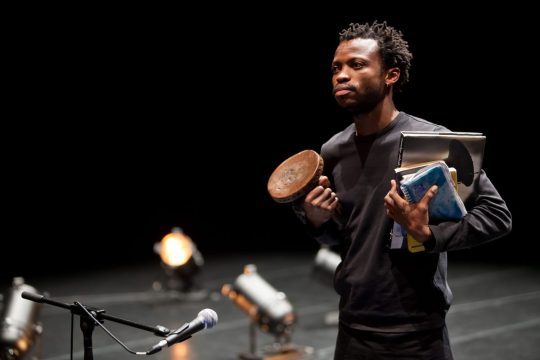
Attention : exceptionnellement le séminaire se tiendra un vendredi
Vendredi 1er juin 2018
Un séminaire dans le séminaire : COSMOCIDES : ART(S), VIOLENCE, 21e SIÈCLE, Guest Curators : Dominique Malaquais et Lionel Manga.
De 19h à 21h, à la MSH, 16-18 rue Suger 75006 Paris (métro Odéon ou Saint-Michel)
Danseur, chorégraphe, Faustin Linyekula a toujours un livre en tête, un chemin à prendre, un sac tout juste défait à refaire, une histoire à raconter, une ruine à reconstruire entre Kisangani où il vit aujourd’hui au Nord-Est de la République Démocratique du Congo (ex Zaïre, ex Congo Belge, ex État indépendant du Congo), Kinshasa, Lisbonne et le monde.
Tout commence à Kisangani avec une bande d’amis férus de théâtre, emmenés par un grand frère, Kabako, qui mourra quelques années plus tard à la frontière de l’Ouganda d’une maladie si anachronique en cette fin de XXe siècle qu’elle n’ose plus guère dire son nom, la peste… En 1993, Faustin quitte un pays de fin de règne -celui de Mobutu- et de début de chaos et s’installe à Nairobi. Débutent alors les allers-retours entre l’Ouganda, le Rwanda et le Kenya. En 1997, il fonde avec Opiyo Okach et Afrah Tenambergen la première compagnie de danse contemporaine au Kenya, Gàara. Leur création initiale, Cleansing, exploration des symboliques du nettoyage et de la purification, est primée aux Rencontres chorégraphiques africaines de Luanda en 1998. Malgré le succès, Faustin quittera la compagnie quelques mois plus tard pour reprendre la route entre la France, l’Afrique du Sud, la Réunion et la Slovénie.
En juin 2001, s’impose le retour au Zaïre devenu République Démocratique du Congo, déchiré par plusieurs années de conflits meurtriers. Le séjour de quelques semaines pour un atelier devient un choix de vie. Faustin met sur pied les Studios Kabako, structure pour la danse et le théâtre visuel, « un lieu où l’on travaille, où toujours on cherche et où parfois l’on trouve, un lieu où l’on doute mais où certains soirs s’impose une certitude ». Avec quatre danseurs qu’il forme, il crée Spectacularly Empty, carnet un rien désespéré d’un retour au pays natal. Commence alors une longue réflexion sur l’histoire et une mémoire collective sans cesse malmenée, bousculée, détournée par des dirigeants en mal de légitimité, incapables de penser le futur, mais aguerris à l’art délicat du passe-passe et de la substitution. Suivent Triptyque sans titre (2002), Spectacularly Empty II (2003), recréation pour boîte noire de la pièce de 2001, Radio Okapi (2003-04), performance mêlant radio en direct et artistes invités, chaque soir différents, Le Festival des mensonges (2005-06), veillée autour de la petite et de la grande histoire du Congo et The Dialogue Series: iii. Dinozord (2006). En 2007, Faustin travaille sur la mise en scène d’un texte de Marie-Louise Bibish Mumbu, La Fratrie errante. En 2008-09, il crée more more more… future, opéra ndombolo rock qui a tourné dans le monde entier et a reçu le Bessie Award de la meilleure composition musicale pour Flamme Kapaya en 2012. En 2009, il met en scène pour la Comédie Française (Studio Théâtre) et le Théâtre de Gennevilliers Bérénice de Jean Racine, une Bérénice qu’il reprend à sa façon et avec des comédiens congolais en 2009 en créant Pour en finir avec Bérénice. En 2011, il imagine son premier solo, Le Cargo, qui tourne toujours sur les scènes du monde entier. L’année suivante, il revisite à la demande du KVS Dinozord, une pièce de 2006 ; naît alors Sur les traces de Dinozord. Après Drums and Digging, présentée au festival d'Avignon en 2013, Faustin signe un solo pour la danseuse sud-africaine Moya Michael, The Dialogue Series: iv Moya (2014), ainsi que le projet Statue of Loss, autour des soldats congolais ayant combattu en Europe lors de la première guerre mondiale. Parmi les autres collaborations, Raimund Hoghe imagine pour Faustin le duo Sans-Titre (2009) et La Création du monde 1923-2012, objet grandiose et non identifié pour 24 danseurs du Ballet de Lorraine (Nancy) et Djodjo Kazadi.
Faustin enseigne régulièrement en Afrique, aux États-Unis (University of Florida - Gainesville, University of Arizona - Tempe) et en Europe (Parts, CNDC Angers, Impulstanz). En 2007, il reçoit le Grand Prix de la Fondation Prince Claus pour la Culture et le Développement et a reçu en 2014 le grand Prix de la Fondation Curry Stone pour le travail développé avec les Studios Kabako sur Kisangani. En 2016, il était Artiste associé de la ville de Lisbonne.
[EN] Faustin Linyekula is a dancer and choreographer. Ever engaged in reading, traveling, breaking new ground, telling novel stories and rebuilding ruins, he lives and works between Kisangani, in North Eastern Democratic Republic of Congo (which was once Zaïre and, before then, the Belgian Congo and, earlier still, the Congo Free State), Kinshasa, Lisbon and the world at large.
His story begins in Kisangani, with a group of theater-loving friends led by one Kabako, who, some years later, near the border of Uganda, would die of a disease few speak of today, the plague. In 1993, as Mobutu Sese Seko’s reign drew to a close and chaos engulfed DRC, Faustin left his country to settle in Nairobi. While moving between Uganda, Rwanda and Kenya, in 1997, with Opiyo Okach and Afrah Tenambergen, he founded Kenya’s first contemporary dance company, Gàara. The company’s first piece, Cleansing, a reflection on rites and symbols of purification, was a prize winner at the 1998 African Choreographic Encounters of Luanda. In spite of this success, a few months later Faustin left Gàara for further travels, this time to France, South Africa, Réunion and Slovenia.
In June 2001, it became clear to Faustin that he needed to return to DRC, which was reeling from years of bloody conflict. What was meant to be a few weeks’ stay for a workshop turned into a life choice. Faustin founded Studios Kabako, an initiative centered on dance and theater – “a place for work, where one seeks and occasionally finds, a space where doubt and, on occasion, absolute certainty rub shoulders”. With four dancers studying at his side, he created Spectacularly Empty, based on his troubling experience of return to his native land. This ushered in a long period of reflection and research on the vagaries of history and collective memory in a country done intense violence by illegitimate and dishonest politicians incapable of imagining the future. Other works followed: Tryptique sans titre (2002); Spectacularly Empty II (2003); Radio Okapi (2003-2004), a performance involving live radio broadcasts and guest artists that, each evening, took on a new form; Le festival des mensonges (2005 2006), a wake in honor of DRC’s (his)stories; and The Dialogue Series: iii. Dinozord (2006). In 2007, Faustin adapted for the stage a text by Congolese writer Marie-Louise Bibish Mumbu, La fratire errante. In 2008-2009, he created more more more… future, a ndobolo rock opera that has since toured very widely and was awarded the Bessie Award for best musical composition in 2012 for its score by Flamme Kapaya. In 2009, Faustin directed Jean Racine’s Bérénice for the Comédie française (Studio Théâtre) and the Genevilliers Theater. Shortly thereafter, he reworked this adaptation with Congolese actors, under the title Pour en finir avec Bérénice. In 2011, he created his first solo, Le Cargo, which is still touring seven years later. In 2012, at the request of the Royal Flemish Theater, he revisited Dinozord, a 2006 piece; this resulted in a new creation titled Sur les traces de Dinozord. Then came Drums and Digging, which was shown at the Avignon Festival in 2013, a solo developed for South African dancer Moya Michael (The Dialogue Series: iv Moya, 2014), and Statue of Loss, in honor of Congolese soldiers who fought in Europe during WWI. Among Faustin’s many collaborations are two in particular that bear note: his work with Raimund Hoghe, who, in 2009, created for Faustin a duo titled Sans titre, and La Création du monde 1932-2012, a 25-dancer piece that Faustin developed for the city of Nancy’s Ballet de Lorraine and dancer Djodjo Kazadi.
On a regular basis, Faustin teaches in Africa, the United States (University of Florida Gainesville, University of Arizona Tempe) and Europe (Parts, CNDC Angers, Impulstanz). In 2007, he was awarded the Prince Claus Fund for Culture and Development’s Principal Award and in 2014 he received the Curry Stone Design Prize for work undertaken with Studios Kabako in Kisangani. In 2016, he was designated Artista na cidade by the city of Lisbon.
Programmation et prochains rendez-vous sur ce site ou par abonnement à la newsletter : [email protected]
Pour regarder les séminaires antérieurs : http://www.vimeo.com/sysk/
Séminaire conçu et organisé par Patricia Falguières, Elisabeth Lebovici et Natasa Petresin-Bachelez et soutenu par la Fundación Almine y Bernard Ruiz-Picasso para el Arte.
0 notes
Text

Japanese General – CIRCA 1890
A strict policy of isolationism and non-interference was instituted by Japan’s Shogun Tokugawa in the early 17th century, resulting in a medieval society locked in time. It was not until the overthrow of the Shogun and his Samurai by imperial forces in 1868 that Japan began to modernize. The reinstatement of full power to the Imperial court and fourteen year old Prince Mutsuhito initiated Japan’s period of industrial growth. The title “Meiji.” which means enlightened peace, was given to the new Emperor and his reign–a period which lasted forty-five years until his death in 1912.
The Meiji Restoration, as this period came to be known, was the beginning of great change in Japan. With the return of power to the young Emperor and the opening of Japan’s seaports in 1854 to Commodore Perry and the American Navy, the Westernization of the country began to take hold. Emperor Meiji encouraged his people to study abroad and return with new ideas and technology. At the same time he invited experts from Europe and America to visit his country and bring with them important information which would assist in Japan’s progress.
The people of Japan, living in a society of extreme politeness and formality which regarded life as a series of ceremonial acts, showed little interest in Beato’s black and white documentary photographs of landscapes, village and trades-people. In an effort to infuse photography with traditional Japanese aesthetics and to gain a greater acceptance for his work, Beato, who was familiar with both the long history of the Japanese colored woodblock prints and the practice of adding color highlights to photographs in Europe, decided to start hand coloring his albumen prints. Working with Wirgman, an accomplished watercolorist, they began selling their delicately tinted photographs. The Japanese people loved them at once, feeling that they were truly Japanese, as was a silk kimono, a painted fan, or a lacquer. They felt these prints were a perfect souvenir for western travelers who desired to collect the cultural and artistic objects of Japan.
The popularity of these hand-colored images was so great that Beato hired Japanese artisans who traditional painted woodblock prints to subtly color his photographs. This time consuming process could take a meticulous painter as long as twelve hours to complete two or three prints. Later this tedious procedure was modified to a production line where several colorists each worked on a particular area of the photographs: one artist colored the faces, then passed it along to another who tinted the clothing. And so on increasing the output to as many as twenty or thirty prints a day.
Another important photographer of Meiji Japan was Austrian-born Baron Raimund von Stillfried. Von Stillfried was a painter who brought his European cultural and artistic background to photography. His work was psychological in character and offered a deeper insight into the lives and social classes of the people he photographed. The photograph he made, primarily in the studio, often incorporated plain backgrounds and a minimal number of props. In 1872 he opened a photography studio in competition with Beato’s firm, and in 1877 von Stillfried purchased Beato’s studio, along with his glass plate negatives and equipment.
While in Japan, Baron von Stillfried apprenticed Japanese assistants in his studio, many of whom later went on to continue the photographic style established by the Europeans. Kusakabe Kimbei was one of his special assistants who had a great talent for the art of photography. He worked closely with von Stillfried and in 1885 purchased most of his photographic stock. He operated his own studio in Yokohama from 1885 to 1912, where he produced portraits, scenes from daily life, and views of Japan. Often Kimkei’s photographs were like theatrical sets in which he was the director. He selected the costumes, backgrounds and props, then carefully positioned the “actor” to reflect the polite social and religious ceremonies, rituals, and customs of the Japanese people.
The photographs of Beato, von Stillfried, Kimbei, and other photographers, many of who have remained anonymous, resembled the Japanese woodblock prints in content, style and coloring technique. Ukiyo-e prints, then the most popular art of Japan, represented the superficial, earthly life that passes quickly. The photographers of the Meiji period used the subjects of the earlier printmakers as models for their photographs, maintaining the Old World sensibilities of their Japanese customers while at the same time satisfying the western demand for pictures of classical Japan. They made portraits of Samurai warriors, street musicians, and tattooed grooms, not as individual personalities, but as stylized representations of social classes. They photographed the serene beauty and landscape of the country showing Mt.Fuji, Lake Hakone, simple teahouses and elaborate temples. The photographers idealized old Japan and ignored its transformation from an insular, medieval country to a modern land. This one -sided photographic view gave outsiders the misleading impression that Japan was a quaint, archaic nation well into the twentieth century.
Source: Richard W. Gadd (Richard Gadd is the Director of the The Monterey Museum of Art, Monterey, California.)
Fascinating Samuraïs… Japanese General - CIRCA 1890 A strict policy of isolationism and non-interference was instituted by Japan's Shogun Tokugawa in the early 17th century, resulting in a medieval society locked in time.
0 notes
Photo

I haven’t posted my Princes family in a while, but here they are again and this will be a sad one.
I thought more about Eileen choosing muggle life and as result came to the idea that maybe Wizarding World damaged her so much that it was unbearable to stay in it.
The art itself is about the story part where the family is blackmailed into work for the Ministry and gets entangled into a web of intrigue that eventually brings two of them (Eileen’s aunt and uncle) to death by the hands of aurors.
Trying to prevent their death, Eileen’s father tries to use his new invention — The Changing Wand — but it’s too late to save them, though the wand still works in its weird way and the desctructive spell stops.
The result is horrifying: the spells can’t finish their job, and the bodies get stuck in their unfinished destruction. Later they become an object of research in Time Room, where Eileen’s father, now forever in Ministry’s hands, works as one of the Unspeakables and tries to bring proper rest to his brother and sister to no avail.
#my art#hp aus#hp headcanons#princes family#hp ocs#eileen snape#eileen prince#magda prince#gustav prince#raimund prince
216 notes
·
View notes
Photo




I’m continuing to figure out/share ideas I have for The Prince Family, so here are some new of them:
Magda makes her prophecies by reading threads of fate and can determine which ones are more important by how bright they shine, but to see them she needs to get into a very specific and dangerous state of looking into the universe itself, which she isn't fond of, so she prefers not to do prophecies voluntary, but she can be triggered into this state, if there is a very bright thread nearby;
Raimund's Changing Wand is the result of many years of research of the creation of magic channeling instruments. The idea of it is that the owner can change the wand to suit them best, but there is a dangerous side to it: the wand can be changed into not only what the owner needs, but also into what the owner wants. Initially Raimund thought that it's a great invention with inestimable potential, but he soon understood the dangers of the latter fact and had to hide the wand before people outside the family learned about it.
Gustav's cane isn't just his mobility aid, but also a instument of wandless magic (similar to how Moody uses his cane), but with a secret: it actually can be combined with a wand and used as an enhancer for certain types of magic.
84 notes
·
View notes
Text
Princes headcanons, part 5 - Random things
I haven't written any new hc in a while, but I got some random stuff in my head I don't know where or who to talk about so. Tumblr, my best abyss that I drop things into, and sometimes it answeres.
1. Context of this art. I got embarrassed and made it into a joke as always, but actual context of it is that Princes acted a lot in the 40s to help both muggles and wizards in the wars that were happening on both sides. They acted outside of any Ministry's boundries and any specific operations or forces that were created, because it would seriously block them from doing anything worthy, so Things Happened and when everything ended they were brought to the Ministry. Gustav is the only one who agrees to talk since it's one of his roles in the family, and the only person who can block him out of his head is Dumbledore, so this interrogation becomes his responsibility. I like to imagine a little maybe cheesy parallel to the future with Albus asking him if they regret what they did at some point, and Gustav answering something along the lines of "only everyone we coulnd't help".
2. That capture and interrogation were actually part of the Ministry's idea to use Princes for their own benefit, which ended in ultimatum: Azkaban or collaboration. They didn't have much choice and chose the last option. As result, Gustav and Albus got stuck working together a lot and got close, although it wasn't really fast with Albus' mind initially barely shifting from Grindelwald he had a duel with not so long ago and Gustav having to dig out his hopes for love he buried long before and overcome his irritation with Dumbledore's secretive sneaky nature (but he didn't just accept it).
3. The changing wand was actually an idea of Raimund's late wife Saoirse. She was a muggle scientist, while Raimund was a wizard inventor, so they liked to ramble their thoughts and ideas to each other, and hearing him talking about wandmaking she came up with a couple of ideas how to make it easier. After her death he got a bit obsessed with the idea.
4. Raimund himself died quite some time after his siblings stuck working for the Department of Mysteries. After Raimund's death they got his brain to research it. On the bright side, during these years he did quite a lot of research and was able to keep copies of it and develop them at home. Later they helped Severus to come up with a way to get Sirius back from behind the Veil.
12 notes
·
View notes